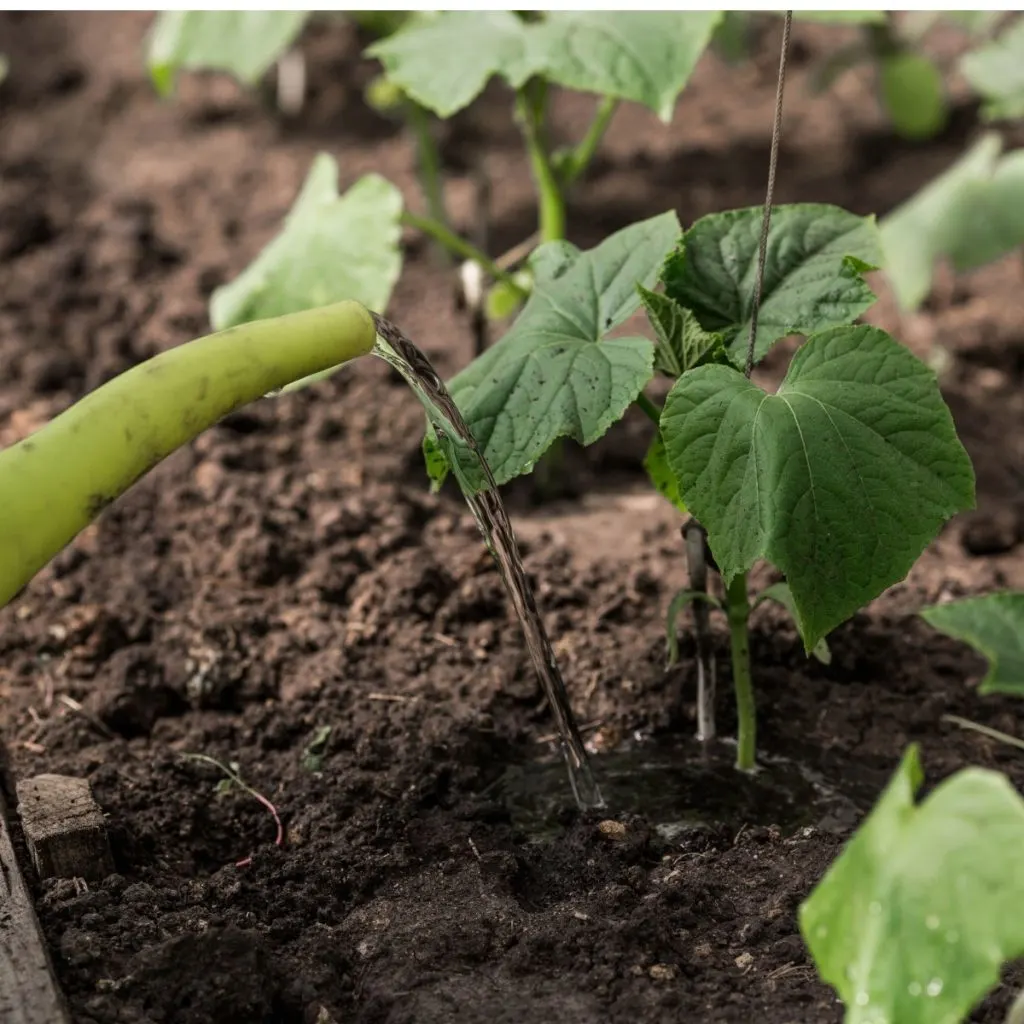Want to avoid the three biggest mistakes gardeners make all too often when watering their vegetable plants?
When it comes to watering a garden – how, when and how often you water plays a big role in the health of your vegetable plants. With proper watering, plants are able to develop strong, deep and healthy roots. But without it, trouble can loom quickly.
Bad watering habits can not only cause plants to suffer from rot or dehydration – it also makes them more susceptible to disease. At the very least, it will certainly lower a plant’s overall yield. And unfortunately, at its worst – it can lead to total plant failure.

The watering needs of any vegetable plant will vary based on the climate and weather conditions where you garden. It goes without saying that if you are trying to grow and water tomatoes in the middle of the desert, it will be much different than attempting to do the same in a more temperate climate.
But with that said, no matter where you happen to live and garden, there are a few watering practices that should always be avoided in order to keep your plants healthy and strong. With that in mind, here is a look at three of the most common watering mistakes – and how to avoid them to water your garden better than ever this year!
The 3 Biggest Mistakes Gardeners Make Watering Their Vegetable Plants
#1 Watering Too Often
By far, overwatering is the most common mistake of all made when watering the garden. As crazy as it sounds, more harm and damage is done to vegetable plants by overwatering garden plants than under-watering.
The only time daily watering is needed are when young transplants or tender seedlings first go in the ground. Transplants usually need watering every day for the first 5 to 7 days. After that, watering every day actually creates more problems than it solves.
Why is that? Because the number one way to develop healthier plants is to allow them to grow a deep, large root structure. Unfortunately, plants that receive water every day never send their roots deeper to look for moisture and nutrients.
Plants that establish deep root systems absorb more water and nutrients. They are also far less vulnerable to extreme weather conditions because their roots are more protected. And best of all, plants with deeper roots need less watering.
So what is so wrong with watering your plants every single day? With daily watering, plants get used to a constant supply of water. Because of that, they never send their roots deeper. This creates a weak root system that leads to a feeble plant with little strength or vigor. Unfortunately, a strong windstorm or a few days without water can spell big trouble for a root poor plant.
The Power Of Watering Deep
Not only does watering too often lead to shallow roots, so does not watering deep enough. When you water your vegetable plants, you need to water deeply.
Be sure that each plant (maturing plants, not seedlings) receives a quarter to a half gallon of water around the root zones. Water slowly so that it absorbs into your plants instead of running off. This too helps the plant develop deeper roots. This is where mulch is so important in helping – especially when it comes to tomato plants! See: How To Water Tomato Plants – The Secret To Watering Tomatoes!
Once a vegetable plant has become established and is mulched properly, it usually only needs water once every week, and that is only if mother nature isn’t providing any.
Listen In Below To Our Podcast On Collecting & Using Rain Water To Water Vegetable Plants!
#2 Watering Vegetable Plants In The Middle Of The Day
The second most common mistake many gardeners make is to water right in the middle of the day. Plain and simple, watering the garden in the middle of the day creates a multitude of problems for vegetable gardens and the plants growing in them – both short term and long term.
Although it may seem like you are giving your plants relief from the scorching sun, in reality, daytime watering can cause serious damage. Plants are at the height of stress at the midpoint of the day. And watering them at this point only adds to the stress.
The leaves, blooms and even the vegetables themselves can easily burn from the water spray heating up from the sunlight. In addition, the water that does reach the soil evaporates at a much faster pace due to the hot sun and heat. It results in far less water getting to your plants where they need it most – their roots!
The Best Time To Water
So when is the best time to water your vegetable plants? The answer is early in the morning. The sun is low, temperatures are cooler, and the plants can soak in the moisture fast and easy. Watering in the morning also allows plants to prepare for the heat of the day with plenty of moisture.
If morning isn’t a possibility, the next best choice is to water in the early evening. Again, plants are at a lower stress level and there is little chance of burning foliage with the hot rays of the sun.
The only drawback of evening watering is that plants can often carry too much moisture through the cool overnight. This has the potential to make conditions ripe for mold and mildew to take hold. If you have cool nights, it’s best to stick with a morning watering routine.
#3 Watering Too Hard
It is never a good idea to water your garden with a big blast of water from a shooting garden hose or sprinkler. We call this the “fire hose” approach to watering, and it creates a myriad of issues for your plants. It can affect their health and certainly their production levels as well!
Watering with a full stream or heavy spray directly on plants can injure leaves and stems. It also can knock off the tender blooms needed to create vegetables. And the fewer blooms there are, the fewer vegetables there will be to harvest in the future!
In addition, spraying the entire garden allows water to easily splash soil on to the foliage of plants. That in turn makes it easy for soil-borne diseases such as blight to infect plants. The tiny droplets of water can also burn foliage when spraying when the sun is out.
Last but not least, spraying is simply the least efficient way to water. As the droplets spray down, much of the moisture evaporates before helping the plant. At the same time, by watering everything, you waste a tremendous amount of water on soil where nothing grows.
The Best Way To Water
When watering, concentrate efforts on the soil only around the root zone of your plant. Not only does it cut down on evaporation – it keeps plants much healthier in the long run by keeping water off of the leaves.
Slow and gentle watering of the root zone is the absolute best way to water. When watering with a hose, remove all nozzles and use a slow, gentle, steady stream of water. Slowly take the hose around the root zones of each plant, going low to the ground.
Removing the nozzle also makes it easier to reach under the top growth of plants to get to the roots. If you have drip hoses, this can be an even better option for watering. They can be a great investment for making watering a breeze!
Simply lay them out under plants, and turn on the faucet. It delivers water slowly right at the root zone with zero effort. Affiliate Link: Flat Soaker Hose 100ft, Garden Hose with Heavy Duty Double Layer Design.
We actually save our gallon milk jugs for watering our garden. We fill them straight from our rain water holding tank. It makes it easy to deliver a quarter to a half-gallon of water per plant right to the roots, without hitting the leaves at all.
Here is to watering your garden for big success this year – and to avoiding three of the biggest watering mistakes many gardeners make! Happy Gardening – Jim & Mary
Old World Garden Farms
Jim and Mary Competti have been writing gardening, DIY and recipe articles and books for over 15 years from their 46 acre Ohio farm. The two are frequent speakers on all things gardening and love to travel in their spare time.
As always, feel free to email us at thefarm@owgarden.com with comments, questions, or to simply say hello! You can sign up for our free email list in the subscribe now box in the middle of this article. Follow us on Facebook here : OWG Facebook. This article may contain affiliate links.



